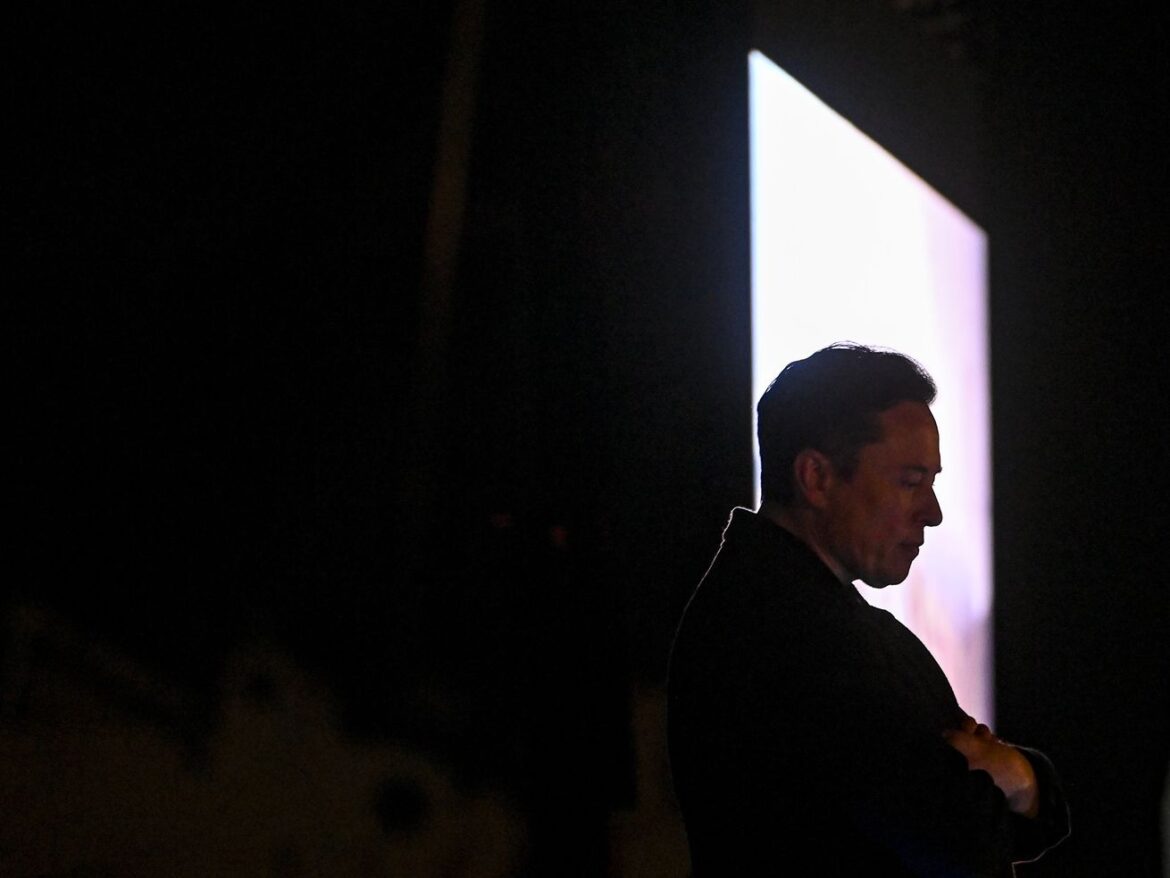The glitchy Ron DeSantis interview is the latest milestone in Twitter’s shift to the right.
Elon Musk’s high-profile Twitter event to launch the presidential bid of Florida Gov. Ron DeSantis on Wednesday got off to a rough start, crashing several times about 30 minutes into the broadcast before restarting the whole thing.
“That was insane, sorry,” said Musk after launching a new audio broadcast on Twitter Spaces about half an hour after the scheduled start time. “We’re actually doing this from David Sacks’s Twitter account because doing it from mine basically broke the system.”
Musk was referring to tech investor and entrepreneur David Sacks, who moderated the interview. Sacks claimed that this was the largest group that has “ever met online.” In reality, the number of people was far smaller than previous online events on or off Twitter. For example, more than 12 million people attended a virtual Travis Scott concert in Fortnite, and according to Twitter, more than 3 million people listened to Musk’s recent Twitter Spaces with the BBC.
During the interview, DeSantis said he chose to announce his presidential bid on Twitter in part because he aligns with Musk’s self-proclaimed free speech values. He also repeatedly criticized the so-called “woke mob” and “woke mind virus,” which is also a grievance of Musk’s.
“I think free speech in this in this country was on its way out the door,” said DeSantis. “That did not happen during Covid. Truth was censored repeatedly, and now that Twitter is in the hands of a free-speech advocate, that would not be able to happen again on this Twitter platform. So I think what was done to Twitter is really significant in the future of our country.”
While DeSantis claims he’s all about free speech, critics say that the Florida governor, like Musk, is actually serving a right-wing agenda that isn’t so free for everyone.
Musk has long claimed he wants Twitter to be a digital town square open to debate from all aspects of the political spectrum.
“For Twitter to deserve public trust it must be politically neutral, which effectively means upsetting the far right and the far left equally,” the billionaire tweeted in April last year, shortly after he made his bid to buy the company.
But lately, Musk has been upsetting one side a lot more than the other. He has been courting some of the most powerful figures in conservative politics to make Twitter their platform of choice, while angering liberals by engaging with conspiracy theories and culture-war-baiting rhetoric.
That approach was clear on Tuesday, when Musk hosted DeSantis on Twitter. It was the first time a presidential candidate has announced their presidential bid on a social media network. It’s also notable that Musk, the company’s owner, is throwing his star power and massive following behind the effort. The DeSantis event happened the same day the Daily Wire, a conservative media outlet that hosts shows by popular right-wing pundits like Ben Shapiro and Matt Walsh, said it would be streaming its shows for free on Twitter. And just two weeks prior, recently fired Fox News host Tucker Carlson said he’s producing a new show that will run on Twitter — another major right-wing media coup for the platform.
While Musk has been busy promoting right-wing powerhouses on Twitter, he hasn’t made any similar public partnerships with liberal politicians, left-leaning or even neutral media outlets. His cozying up to the right seems to be alienating some liberal users. A recent Pew study shows that Twitter users who identify as Democrats were almost 10 percent more likely to say they would stop using the platform in a year (the partisan gap was even greater with Democratic women than men). And in the weeks after Musk took over Twitter, high-profile Republican Twitter accounts gained tens of thousands of followers while their Democratic counterparts experienced a decline, according to a Washington Post analysis.
It’s Musk’s prerogative to encourage whoever he wants on Twitter. While he says he will soon be stepping down as CEO and handing the position to former NBCUniversal ad executive Linda Yaccarino — who has her own conservative credentials as a well-known Trump supporter — Musk still controls and runs the company.
If we go back to Musk’s original stated reason for acquiring Twitter, which he reiterated shortly after he first took control of the company, he said it’s “important to the future of civilization to have a common digital town square, where a wide range of beliefs can be debated in a healthy manner, without resorting to violence,” and that “there is currently great danger that social media will splinter into far right wing and far left wing echo chambers that generate more hate and divide our society.”
Musk went on to critique mainstream media, “in relentless pursuit of clicks, much of traditional media has fueled and catered to those polarized extremes, as they believe that is what brings in money, but in doing so, the opportunity for dialogue is lost.”
But now, Musk is shifting Twitter toward the polarized, echo-chamber model of media he criticized. It’s not just that he is welcoming more right-wing voices onto Twitter. He’s also enabling them to seem more authoritative, boosting their voices, and allowing more controversial speech.
Musk has allowed neo-Nazis, white supremacists, and other hateful accounts back on his platform under his “freedom of speech but not freedom of reach” approach to content moderation. While Musk says that Twitter doesn’t endorse hateful content and won’t amplify it in people’s feeds, the fact that these accounts are allowed on the platform has turned off some users. But conservative accounts have embraced Musk’s new hate speech policies, and paid their way into being verified under Musk’s new check mark system, which allows their content to show up higher in replies and comments. At the same time, Musk has stripped check marks from many media organizations, reporters, and politicians who refuse to pay for verification, making Twitter’s new check-marked class look markedly more right-wing. And Musk has repeatedly broken his promises to allow speech he disagrees with onto the platform by temporarily banning journalists, comedians, and others who draw his ire.
DeSantis, like Musk, has been accused of contradicting his free-speech values: The governor has endorsed controversial new legal reforms in his state restricting how schools can talk to students about gender and race in the classroom.
Musk could embrace the new reality that Twitter is now a place where conservative voices are often welcomed by the company’s owner, and liberal ones are attacked. But somehow, he continues to hold on to the digital town square dream despite his failure to bring that vision to fruition.
In a Wall Street Journal talk on Tuesday, Musk said he “absolutely” wants to also interview Democrats and politicians across the spectrum. It’s unclear, though, whether Democratic politicians would want to go on Twitter to interview with Musk, who — like it or not — is now seen as being publicly aligned with conservatives.
“I am interested in X/Twitter being somewhat of a public town square where more and more organizations post content and make announcements on Twitter,” Musk said in the WSJ interview.
But what kind of public town square is Musk building if one side is welcomed with open arms and the other is attacked? The Atlantic’s Charlie Warzel has argued that Twitter has evolved into a far-right-wing platform. Sara Fischer and Mike Allen at Axios wrote that “the center of media gravity” is moving from Fox News to Twitter. One could also argue that it’s not quite there yet because of all the left-leaning or apolitical holdouts who, despite all the drama, just can’t seem to quit Twitter. But if it continues to alienate a wide swath of users, Twitter will turn into something more similar to Trump’s Truth Social or the now-defunct Parler: echo chambers of conservative voices.
Musk has the power to drive attention to the politicians he favors by controlling the fire hose of information on Twitter. Musk has the ability to boost DeSantis, Carlson, and other conservatives he’s partnering with on Twitter so that they’re plastered all over people’s timelines. He has already given these figures free promotion and a launching pad at pivotal stages in their careers. Ultimately, it’s Musk who controls the Twitter fire hose of information. Let’s also not forget that he tweets to his 140 million Twitter followers on a daily basis.
A number of outlets, including this one, have recently reported that Twitter as we know it is dying. But a more updated conclusion is that it’s being reborn as something else entirely, something certainly more right-leaning, and possibly even more of a polarized hellscape than the Twitter before it. In any case, it’s clear now that the Twitter Musk is building is not the all-inclusive digital square he promised, but it is the one he wants.
Update, May 24, 7:50 pm ET: This story has been updated with details from the DeSantis Twitter broadcast event.



